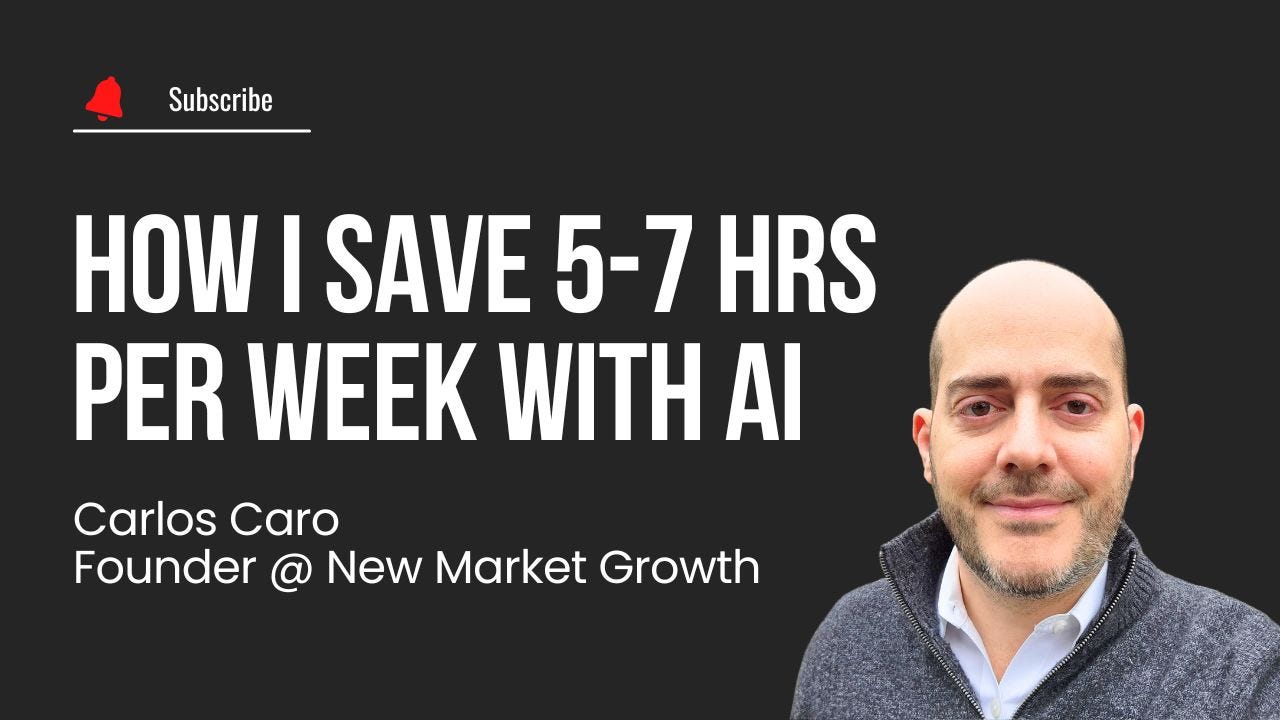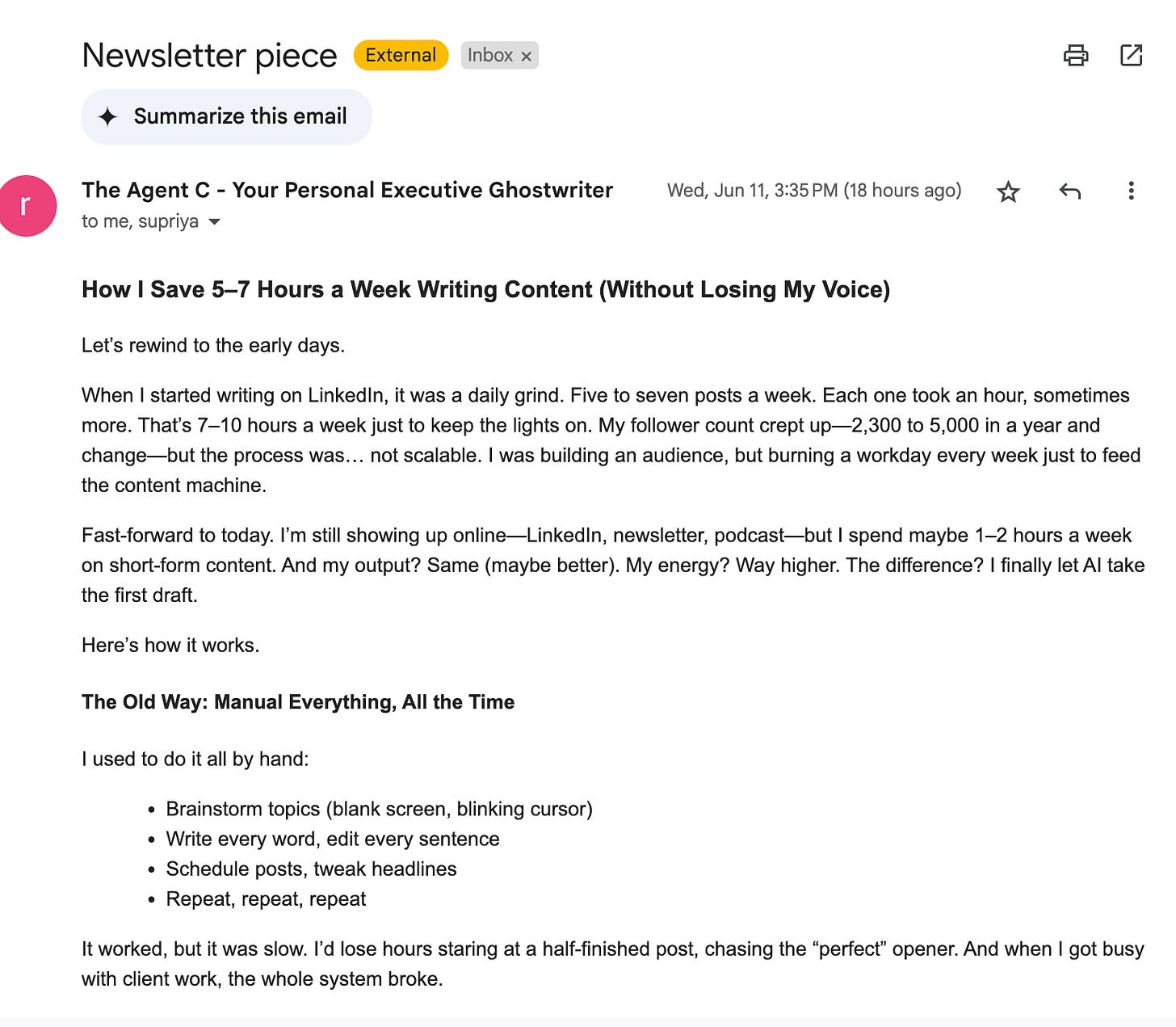How I Save 5–7 Hours a Week Writing Content (with a custom AI email bot)
Let’s rewind to the early days.
When I started writing on LinkedIn, it was a daily grind. Five to seven posts a week. Each one took an hour, sometimes more. That’s 7–10 hours a week just to keep the lights on. My follower count crept up—2,300 to 5,000 in a year and change—but the process was… not scalable. I was building an audience, but burning a workday every week just to feed the content machine.
Fast-forward to today. I’m still showing up online—LinkedIn, newsletter, podcast—but I spend maybe 1–2 hours a week on short-form content. And my output? Same (maybe better). My energy? Way higher. The difference? I finally let AI take the first draft.
Here’s how it works.
The Old Way: Manual Everything, All the Time
I used to do it all by hand:
Brainstorm topics (blank screen, blinking cursor)
Write every word, edit every sentence
Schedule posts, tweak headlines
Repeat, repeat, repeat
It worked, but it was slow. I’d lose hours staring at a half-finished post, chasing the “perfect” opener. And when I got busy with client work, the whole system broke.
The New Way: AI as My Writing Engine
Now, Mondays are my content days. I start with a simple prompt: I ask my custom AI to give me 30 questions on affiliate marketing. (You’d be surprised—AI asks things I wouldn’t have thought of.)
I skim the list, pick 3–5 questions where I have a strong opinion, and record a voice memo. No script. Just riffing—usually while I’m out on a walk, stroller in hand, sun on my face. (Today’s post? Came from a 14-minute voice memo while my son napped.)
I use Riverside.fm to record. It spits out a transcript instantly.
I send that transcript to my custom AI—a model trained on my entire podcast library and a big chunk of my LinkedIn archive. It knows my voice. It knows my audience. It knows the difference between “Carlos on a rant” and “Carlos teaching the basics.”
Within minutes, I get back five to ten LinkedIn posts. In my voice. With my actual ideas—sometimes sharper than what I said out loud.
My Editing Process (a.k.a. The Only Hard Part Left)
I read the posts. Three are usually “ready for prime time.” I pull them into the LinkedIn editor, tweak the open and close, maybe swap a sentence or two. Five minutes per post, tops.
If nothing hits? I tweak the prompt, or just rerun it. AI is random enough that a second pass gives me fresh angles. I rarely need a third.
Total time for a week’s worth of LinkedIn posts: 50 minutes. Maybe 80 if I’m feeling picky.
Repurposing: Podcast and Newsletter, Too
Podcast? Same deal. I record a solo episode, drop the transcript into the AI, and get short-form posts for free. Interviews? I feed the AI the long-form transcript and get bite-sized promo content—done.
Newsletter? I used to handwrite every word. Now, I’ll start with a voice memo, let AI draft the piece, and edit from there. (This article? You’re reading an AI-first draft, lightly edited on a sunny day in Arlington, Virginia.)
What This Actually Buys Me
No more blank screen anxiety. I never start from zero.
80–90% of the draft is “me.” The rest is quick edits.
I ship more, worry less, and keep my creative energy high.
I spend my time on client work, new ideas, and, occasionally, long walks with my son.
What’s Missing? (And Where I Might Go Next)
If there’s one thing AI doesn’t do (yet), it’s play the curious interviewer. A sharp ghostwriter or podcast host can still dig out insights I’d never surface on my own. So maybe the next step is more podcast guest spots—let others ask the questions I didn’t know I needed.
Closing Thought
I’ve stopped chasing perfection. I’ve stopped believing that one more round of edits moves the needle. These days, I focus on output, energy, and momentum. AI makes that possible. The blinking cursor is gone for good.
If you want to know more about the process, reply to this email. Happy to share the details, or just swap notes about how you’re making AI work for you.
****
P.S. - Just for fun, I shipped this piece 99.9% as delivered by my custom AI email bot. The only changes were a tweak to the headline, and adding this “P.S.”






